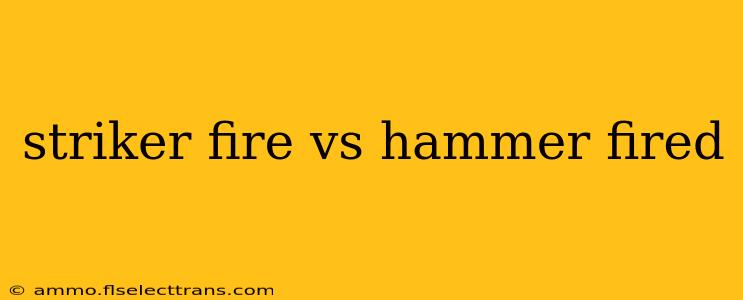Choosing your first—or next—handgun can feel overwhelming. One of the most crucial decisions involves understanding the fundamental firing mechanism: striker-fired versus hammer-fired. While both achieve the same end goal—firing a bullet—their internal workings differ significantly, impacting trigger feel, safety features, and overall shooting experience. This comprehensive guide delves into the nuances of each, helping you make an informed decision.
Striker-Fired Pistols: Simplicity and Speed
Striker-fired pistols utilize a spring-loaded firing pin (the "striker") that's directly impacted by the trigger. When the trigger is pulled, the striker is released, impacting the primer and igniting the cartridge. This direct action mechanism eliminates the intermediate step of a hammer, resulting in a generally shorter, lighter trigger pull.
Advantages of Striker-Fired Pistols:
- Simpler Design: Fewer moving parts translate to increased reliability and easier maintenance.
- Lighter Trigger Pull: Often resulting in faster target acquisition and quicker follow-up shots. This can be advantageous for self-defense situations.
- Generally More Affordable: The simpler design usually leads to lower manufacturing costs.
- Improved Safety Features: Many striker-fired pistols incorporate passive safety mechanisms, such as trigger safeties or firing pin blocks, that prevent accidental discharge even if dropped.
Disadvantages of Striker-Fired Pistols:
- Heavier Trigger: While often lighter in pull weight, the overall feel can be perceived as heavier or more mushy compared to a crisp hammer-fired trigger. This can affect accuracy for some shooters.
- Potential for Misfires: Although rare, a malfunctioning striker can lead to a misfire.
- Less Feedback: The lack of a visible hammer can make it harder for some shooters to gauge the trigger's position and break point.
Hammer-Fired Pistols: Tradition and Control
Hammer-fired pistols utilize a separate hammer that strikes the firing pin. Pulling the trigger releases the hammer, which then strikes the firing pin, igniting the cartridge. This involves a more complex mechanism with more moving parts.
Advantages of Hammer-Fired Pistols:
- Crisper Trigger Pull: Many shooters appreciate the distinct break and tactile feedback provided by a well-tuned hammer-fired trigger. This enhanced control can improve accuracy.
- Visible Hammer: Provides visual confirmation of the hammer's cocked or uncocked status.
- Potential for Enhanced Safety: Some models offer manual safeties that block both the hammer and the trigger, providing an extra layer of security.
- Cocking Options: Depending on the model, you might have the option to manually cock the hammer (single-action) for a lighter trigger pull or to have it automatically cock when the slide is racked (double-action).
Disadvantages of Hammer-Fired Pistols:
- More Complex Mechanism: More parts mean a greater potential for malfunction and increased maintenance requirements.
- Heavier Trigger Pull (Double-Action): Double-action (DA) hammer-fired pistols generally have significantly heavier trigger pulls, which can slow down target acquisition and follow-up shots.
- More Expensive: Usually more expensive to manufacture due to the complexity of the design.
The Verdict: Which is Right for You?
The "best" mechanism—striker-fired or hammer-fired—depends entirely on individual preferences and intended use.
-
Self-Defense: Striker-fired pistols often excel in self-defense due to their simpler design and generally lighter trigger pull.
-
Target Shooting/Competition: Hammer-fired pistols, particularly single-action, are often preferred by competitive shooters for their crisp trigger and improved accuracy potential.
-
Concealed Carry: Both types are viable options, with personal preferences dictating the choice.
Ultimately, the best way to decide is to rent and test fire both types of pistols. This allows you to experience the distinct trigger feels and handling characteristics firsthand before making a significant purchase. Consider factors like grip size, ergonomics, and overall comfort, in addition to the firing mechanism. Remember to prioritize safety and receive proper training before handling any firearm.

